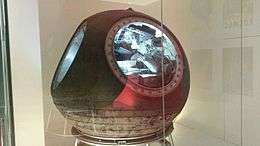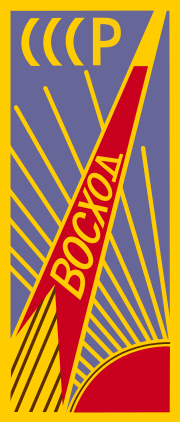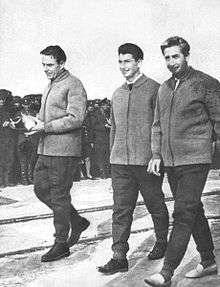Voskhod 1
 Voskhod 1 capsule in a museum display (2016) | |||||
| Operator | Soviet space program | ||||
|---|---|---|---|---|---|
| COSPAR ID | 1964-065A | ||||
| SATCAT № | 904 | ||||
| Mission duration | 1 day, 17 minutes, 3 seconds | ||||
| Orbits completed | 16 | ||||
| Spacecraft properties | |||||
| Spacecraft | Voskhod-3KV No.3 | ||||
| Manufacturer | Experimental Design Bureau OKB-1 | ||||
| Launch mass | 5,320 kilograms (11,730 lb) | ||||
| Crew | |||||
| Crew size | 3 | ||||
| Members |
Vladimir Komarov Konstantin Feoktistov Boris Yegorov | ||||
| Callsign | Рубин (Rubin - "Ruby") | ||||
| Start of mission | |||||
| Launch date | 12 October 1964, 07:30:01 UTC[1] | ||||
| Rocket | Voskhod 11A57 | ||||
| Launch site | Baikonur 1/5[1] | ||||
| End of mission | |||||
| Landing date | 13 October 1964, 07:47:04 UTC | ||||
| Landing site | 52°2′N 68°8′E / 52.033°N 68.133°E | ||||
| Orbital parameters | |||||
| Reference system | Geocentric | ||||
| Regime | Low Earth | ||||
| Perigee | 178 kilometres (111 mi) | ||||
| Apogee | 336 kilometres (209 mi) | ||||
| Inclination | 64.7 degrees | ||||
| Period | 89.6 minutes | ||||
  Voskhod 1 crew after landing
| |||||
Voskhod 1 (Russian: Восход-1, Восход is Russian for Sunrise) was the seventh manned Soviet space flight. It achieved a number of "firsts" in the history of manned spaceflight, being the first space flight to carry more than one crewman into orbit, the first flight without the use of spacesuits, and the first to carry either an engineer or a physician into outer space. It also set a manned spacecraft altitude record of 336 km (209 mi).[2]
The three spacesuits for the Voskhod 1 cosmonauts were omitted; there was neither the room nor the payload capacity for the Voskhod to carry them. The original Voskhod had been designed to carry two cosmonauts, but Soviet politicians pushed the Soviet space program into squeezing three cosmonauts into Voskhod 1. The only other space flight in the short Voskhod program, Voskhod 2, carried two suited cosmonauts — of necessity, because it was the flight on which Alexei Leonov made the world's first walk in space.[3]
As part of its payload Voskhod 1 carried a ribbon off a Communard banner from the Paris Commune of 1871 into orbit.[4]
Cosmonauts
| Position | Cosmonaut | |
|---|---|---|
| Command Pilot | Vladimir Komarov First spaceflight | |
| Engineer | Konstantin Feoktistov Only spaceflight | |
| Medical Doctor | Boris Yegorov Only spaceflight | |
Back-up crew
| Position | Cosmonaut | |
|---|---|---|
| Command Pilot | Boris Volynov | |
| Engineer | Georgi Katys | |
| Medical Doctor | Aleksei Sorokin | |
Reserve Cosmonaut
| Position | Cosmonaut | |
|---|---|---|
| Medical Doctor | Vasili Lazarev | |
Mission parameters
- Mass: 5,320 kg (11,730 lb)
- Perigee: 178 km (111 mi)
- Apogee: 336 km (209 mi)
- Inclination: 64.7°
- Period: 89.6 min
Background

The original prime crew of cosmonauts for Voskhod 1, composed of Boris Volynov, Georgi Katys, and Boris Yegorov, was rejected just three days before the scheduled launch date for the space capsule. Katys was reportedly removed after the KGB discovered that his father had been shot during the Great Purge in 1937 and Volynov apparently was the victim of discrimination due to his part-Jewish background, although he would later fly on Soyuz 5 and Soyuz 21.[5]
Politics played a role in the crew's selection. Various factions each supported their own representatives for the flight. Sergei Korolev wanted his engineers to become cosmonauts, believing that spacecraft designers should fly in their own vehicles. The Soviet Air Force agreed to a crew composed of a military pilot, an engineer or scientist, and a doctor, but advocated for an all-military crew. Konstantin Feoktistov, who had been a design engineer for the Vostok, Voskhod, and Soyuz programs, was selected for this flight, becoming the only Soviet outer space designer to make a spaceflight. Yegorov, a medical doctor, used his political influence to get selected for the crew through his father's Politburo connections. The Soviet space program viewed its crews as passengers more than pilots; the new cosmonauts received only three to four months of training, perhaps the briefest in space history other than that received by the American politicians Jake Garn and Bill Nelson for Space Shuttle flights in the 1980s.[6]:413–414,416
Mission highlights

The Voskhod spacecraft were basically Vostok spacecraft with a backup, solid-fuel retro-rocket added onto the top of the descent module. The ejection seat was removed and three crew couches were added to the interior at a 90-degree angle to that of the Vostok cosmonaut's position. Because of the cramped conditions, the cosmonauts also had to go on a diet to fit in their couches. A solid-fuel braking rocket was also added to the space capsule's parachute lines to provide for a softer landing at touchdown. This was necessary because, unlike the Vostok space capsule, no ejection seats were fitted in the Voskhod; the cosmonauts had to land inside the descent module.[7] Aside from that, the Vostok booster had lacked sufficient payload capacity to support the extra weight of a retrorocket package, however the larger upper stage used on the 11A57 launch vehicle meant that this was no longer an issue. As there was no launch escape system, the mission could not be aborted until three minutes after liftoff when the payload shroud was jettisoned and so a low-altitude booster accident would have meant the loss of the crew. As the cosmonauts rode the gantry elevator to the top of the launch vehicle, they could look across the steppe which was strewn with debris from previous failed R-7 launches, a grim reminder of what could potentially happen on their flight.
Liftoff took place at 7:30 on the morning of 12 October and for the first few minutes of the launch, the blockhouse was extremely tense knowing that the cosmonauts were doomed if any problem with the booster developed. Much of the mission of Voskhod 1 was devoted to biomedical research, and to the study of how a multi-disciplinary team could work together in space. The mission was short, at only slightly over 24 hours. Incidentally, the Soviet premier Nikita Khrushchev was removed from power during the spaceflight, and it has been speculated that this led to the mission being cut short.[8] However, the cramped conditions of the Voskhod space capsule has also been suggested as a factor ruling out a longer-duration spaceflight.[2]
During the flight, Khrushchev spoke with the cosmonauts via radio phone from his dacha in the Crimea. Shortly after this conversation, he was summoned back to Moscow where he learned that he was being expelled from office and the Communist Party. When the crew returned to Earth the next day, they were greeted by Leonid Brezhnev and Alexei Kosygin in their first public appearance as leaders of the Soviet Union.
Despite the propaganda boasting around Voskhod 1, it was privately referred to by the leadership of the Soviet space program as "a circus" due to the messy process of crew selection, the cosmonauts needing to diet to fit inside their spacecraft, Khrushchev's expulsion during the flight, and also the extremely dangerous circumstances of it (the crew having neither pressure suits nor any way to escape from a malfunctioning launch vehicle).
Happening as it did before the beginning of the Project Gemini two-man flights, Voskhod 1 had a significant, but temporary, international impact. The NASA Administrator, James E. Webb, called the flight of Voskhod 1 a "significant space accomplishment" adding that it was "a clear indication that the Russians are continuing a large space program for the achievement of national power and prestige."[2]
See also
Notes
- 1 2 "Baikonur LC1". Encyclopedia Astronautica. Retrieved 2009-03-30.
- 1 2 3 "Voskhod 1". www.astronautix.com. Retrieved 2015-11-27.
- ↑ "Voskhod 2". www.astronautix.com. Retrieved 2015-11-27.
- ↑ Horne, Alistair (1965). The Fall of Paris. Macmillan. p. 433.
- ↑ "Volynov". www.astronautix.com. Retrieved 2015-11-27.
- ↑ Siddiqi, Asif A. Challenge To Apollo: The Soviet Union and the Space Race, 1945-1974. NASA.
- ↑ "Spaceflight mission report: Voskhod 1". www.spacefacts.de. Retrieved 2015-11-27.
- ↑ An example appears in The Times obituary of Feoktistov:
References
- "Voskhod 1". Encyclopedia Astronautica. Retrieved 2008-08-10.
